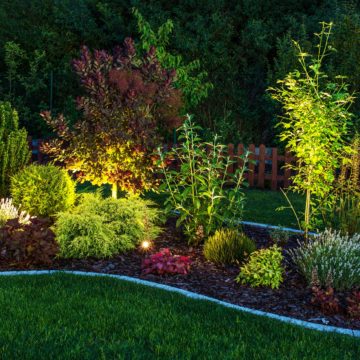Professional landscape lighting adds beauty, character and safety to your home. Path lights, accent lights and deck lights enhance the unique styling of your property, while offering the functionality and peace of mind of a well-lit outdoor space
Landscape Lighting
Why install outdoor lighting?
- Increases curb appeal. Outdoor lighting increases the value and resale of your home while complimenting your landscaping investments.
- Energy and cost efficient. Low voltage, 12-volt lighting systems are less expensive to install and maintain and burn 80% less energy than high voltage lighting system, which operate at 120 volts.
- Installation with minimal disturbance. All lights are installed by hand, which allows us to avoid any disruption to your landscaping or property.
- Added sense of safety and security. An experienced lighting designer can create a nighttime atmosphere that adds safety to your home by lighting up walkways and entertaining areas to freely move around in. A well-lit landscape has also been statistically proven to discourage trespassing and burglaries.
- Set your home apart: Summit Irrigation and Lighting deploys a wide assortment of custom lighting techniques that focus on enhancing your homes exterior features and garden areas to create warmth and ambiance to make your home stand apart from the others.

Lighting Techniques

Moon Lighting
Shining light down, usually from a tree, to cast shadows of branches and leaves on the ground to provide a moonlight effect. Excellent technique for gentle ambiance, as well as security without the harsh glare of traditional house flood lights.

Uplighting
This is the opposite of moonlighting and refers to shining light up, usually into a tree or other upright landscape feature, to softly accent its features. Excellent technique to bring the landscape alive at night, providing depth and beauty to an otherwise dark yard.

Grazing
Shining light across the surface of a landscape feature to accent the feature’s texture. Excellent technique to bring alive old stone work, brick chimneys, or walls at night, or to highlight planting contours in beds throughout the yard to emphasize the beauty of the bark on that special old tree.

Spot Lighting
Using a controlled intense beam to highlight the focal points in a garden such as statues, sculptures and specimen shrubs.

Cross Lighting
Lighting a tree or statue from two or more directions to reveal a three-dimensional perspective.

Path Lighting
Attractive and unique light fixtures, usually 1′-3′ tall, placed next to driveways, walkways, garden paths or decks provide a low level light for beauty, safety and security.

Silhouetting
Placing a fixture directly behind the subject and pointing it at a vertical surface to display a dark outline of the subject to the foreground observer, creating a dramatic silhouette effect. This is a great technique to highlight trees and plants with interesting branch structure.

Shadowing
Lighting an object from the front and below to project intriguing shadows on a wall or other vertical surfaces. This is another way to highlight interesting shapes and branch structure.

Deck, Step Lights
Provide low-level, discrete lighting with these marvelous little fixtures. These fixtures are mounted under deck rails or recessed into the sides of steps to provide safety and accent lighting. Also available as hanging fixtures for structures like arbors and trellises.
How Do Low-Voltage Landscape Lighting Systems Work?
Unlike line voltage, which is 120 volts, low-voltage lighting only uses 12 volts to power all light fixtures — we do not need to install dangerous electrical wires with the constant threat of shock or injury.
The main component for distributing safe voltage to all landscaping lights is the transformer. Each transformer lowers the home’s 120V system down to 12V. Each manufacturer makes transformers with different ratings.
Wires connect to the transformer and stretch out along the ground to attach to each light fixture. This wire may simply lay on the soil or can be buried up to 3 inches deep under soil or mulch. Because of the low voltage running through the wires, there is no threat of shock. The wiring’s thickness determines the brightness of all of your landscape lights.
Light fixtures are usually placed 10 feet from the transformer and each other. Low-voltage lighting is versatile because you can mix any fixture types you want along the same transformer line, from patio wall lights to walkway lights. We calculate each bulb’s wattage on one line to ensure the power rating does not exceed the transformer’s ability.
To save on electricity costs, we can attach a photocell to your transformer so the lights automatically come on at sunset and go off at sunrise. Or, use a timer and set it so the lights come on and go off when you want them to. Photocells take advantage of the ambient light and turn the system on when the sun sets. Both of these accessories use a switching system to block and provide power when needed to the transformer.
What is LED lighting?
LED stands for Light Emitting Diode. This is light produced using a semiconductor in a process called electroluminescence. The process is much more efficient than traditional incandescent lights and have much longer lifespans. The LED’s small size and relatively cooler operating temperature means that it can be used in shapes and forms that would have been impossible to light with traditional bulbs. LED lights produce 90% less heat than the standard halogen lights. They do not produce any radiant heat, and are cool to the touch in the direction where light is dispersing.

